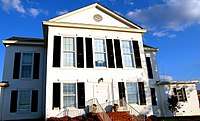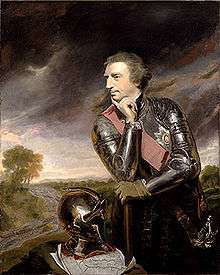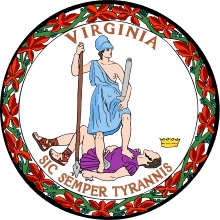Amherst County, Virginia
| Amherst County, Virginia | ||
|---|---|---|
 Amherst County Courthouse | ||
| ||
 Location in the U.S. state of Virginia | ||
 Virginia's location in the U.S. | ||
| Founded | 1761 | |
| Named for | Jeffery Amherst | |
| Seat | Amherst | |
| Largest town | Amherst | |
| Area | ||
| • Total | 479 sq mi (1,241 km2) | |
| • Land | 474 sq mi (1,228 km2) | |
| • Water | 4.9 sq mi (13 km2), 1.0% | |
| Population (est.) | ||
| • (2015) | 31,914 | |
| • Density | 68/sq mi (26.3/km2) | |
| Congressional district | 6th | |
| Time zone |
Eastern Coordinates: 37°37′N 79°08′W / 37.61°N 79.14°W | |
| Website |
www | |
Amherst County is an American county, located in the Piedmont region and near the center of the Commonwealth of Virginia. The county is part of the Lynchburg, VA Metropolitan Statistical Area, and its county seat is Amherst.[1]
Amherst County was created in 1761 out of Albemarle County, and it was named in honor of Lord Jeffery Amherst, the so-called "Conqueror of Canada". The county was subsequently reduced in size in 1807 in order to give up land to form Nelson County. Tobacco was the major cash crop of the county during its early years.
As of the 2010 census, the population of the county was 32,353, a small increase from the 31,894 people reported in the 2000 census.[2]
History

Native Americans were the first humans to populate the area. They hunted and fished mainly along the countless rivers and streams in the county. With the establishment of the Virginia Colony in 1607, English emigrants arrived in North America. By the late 17th century English explorers and traders traveled up the James River to this area. Early trading posts formed between 1710 and 1720. By 1730, many new families moved into the land currently known as Amherst County drawn by the desire for land and the good tobacco-growing soil.
Amherst County was formed in 1761, from part of southwestern Albemarle County. The original county seat had been in Cabelsville, now Colleen in what would later become Nelson County. The county was named for Lord Amherst, known as the "Conqueror of Canada", who commanded the British forces that successfully secured Canada from the French. Jeffery Amherst had also previously been named Governor of Virginia, although he never came to the colony. In 1806 the county assumed its present proportions when Nelson County was formed from its northern half. At that point, the county seat was moved to the village of Five Oaks, later renamed Amherst. The present county courthouse was built in 1870 and has served the county ever since. On a historically interesting note, Amherst County produced more Confederate soldiers per capita than anywhere else in the C.S.A.
In the early days, the major crop raised in Amherst County was tobacco. Apple orchards were part of mixed farming that replaced tobacco, especially in the late 19th century. Timber, mining and milling were also important industries. The introduction of the railroad in the late 19th century greatly influenced the county's growth. The county contains many good examples of 18th, 19th and early 20th century rural and small town architecture. The downtown area of Amherst is a classic example of early 20th century commercial architecture.
Local attractions
There are numerous attractions throughout the county that entertain many people throughout the area. With the three recreational and public lakes being Mill Creek, Thrashers Lake, and Stonehouse Lake, there is plenty to do on the water. Many like to fish, canoe, or kayak in the water or simply have a cookout along the side of the lakes. There are also many trails and parks that anyone is welcome to visit at any time. There is a significant portion of the Appalachian Trail that runs through the George Washington National Forest in Amherst. There are many offshoot trails that highlight peaks in Amherst such at Mt. Pleasant, Cold Mountain, and Tar Jacket Ridge. There are many local restaurants in the county such at the Briar Patch, Travelers, Vitos Grill, Charlies Chicken, and many others that are very popular spots among the locals who frequent the various eateries.
Festivals in the area
- Rebec Vineyard's Garlic Festival
- Lazy Days Vineyard's Summer Solstice Festival
- Amherst County Sorghum Festival
- The Batteau Festival
Geography

According to the U.S. Census Bureau, the county has a total area of 479 square miles (1,240 km2), of which 474 square miles (1,230 km2) is land and 4.9 square miles (13 km2) (1.0%) is water.[3]
Adjacent counties / Independent city
- Rockbridge County, Virginia – northwest
- Nelson County, Virginia – northeast
- Appomattox County, Virginia – southeast
- Campbell County, Virginia – south
- Lynchburg, Virginia – south (independent city)
- Bedford County, Virginia – southwest
National protected areas
- Blue Ridge Parkway (part)
- George Washington National Forest (part)
Major highways
Demographics
| Historical population | |||
|---|---|---|---|
| Census | Pop. | %± | |
| 1790 | 13,703 | — | |
| 1800 | 16,801 | 22.6% | |
| 1810 | 10,548 | −37.2% | |
| 1820 | 10,423 | −1.2% | |
| 1830 | 12,071 | 15.8% | |
| 1840 | 12,576 | 4.2% | |
| 1850 | 12,699 | 1.0% | |
| 1860 | 13,742 | 8.2% | |
| 1870 | 14,900 | 8.4% | |
| 1880 | 18,709 | 25.6% | |
| 1890 | 17,551 | −6.2% | |
| 1900 | 17,864 | 1.8% | |
| 1910 | 18,932 | 6.0% | |
| 1920 | 19,771 | 4.4% | |
| 1930 | 19,020 | −3.8% | |
| 1940 | 20,273 | 6.6% | |
| 1950 | 20,332 | 0.3% | |
| 1960 | 22,953 | 12.9% | |
| 1970 | 26,072 | 13.6% | |
| 1980 | 29,122 | 11.7% | |
| 1990 | 28,578 | −1.9% | |
| 2000 | 31,894 | 11.6% | |
| 2010 | 32,353 | 1.4% | |
| Est. 2016 | 31,633 | [4] | −2.2% |
| U.S. Decennial Census[5] 1790–1960[6] 1900–1990[7] 1990–2000[8] 2010–2013[2] | |||
As of the census[9] of 2000, there were 31,894 people, 11,941 households, and 8,645 families residing in the county. The population density was 67 people per square mile (26/km²). There were 12,958 housing units at an average density of 27 per square mile (11/km²). The racial makeup of the county was 77.67% White, 19.79% Black or African American, 0.81% Native American, 0.35% Asian, 0.02% Pacific Islander, 0.41% from other races, and 0.94% from two or more races. 0.96% of the population were Hispanic or Latino of any race.
There were 11,941 households out of which 31.70% had children under the age of 18 living with them, 56.00% were married couples living together, 12.40% had a female householder with no husband present, and 27.60% were non-families. 24.00% of all households were made up of individuals and 9.90% had someone living alone who was 65 years of age or older. The average household size was 2.51 and the average family size was 2.95.
In the county, the population was spread out with 23.50% under the age of 18, 9.70% from 18 to 24, 27.70% from 25 to 44, 25.30% from 45 to 64, and 13.80% who were 65 years of age or older. The median age was 38 years. For every 100 females there were 91.10 males. For every 100 females age 18 and over, there were 87.10 males.
The median income for a household in the county was $37,393, and the median income for a family was $42,876. Males had a median income of $31,493 versus $22,155 for females. The per capita income for the county was $16,952. About 8.00% of families and 10.70% of the population were below the poverty line, including 13.20% of those under age 18 and 11.60% of those age 65 or over.
Government
Board of Supervisors
- District 1: Ken Campbell (I)
- District 2: Claudia Tucker (I) Chairman
- District 3: Jimmy Ayers (I)
- District 4: David Pugh, Jr. (R) Vice Chairman
- District 5: John Marks Jr. (I)
Constitutional officers
- Clerk of the Circuit Court: Roy C. Mayo, III (I)
- Commissioner of the Revenue: Jane Irby (I)
- Commonwealth's Attorney: Stephanie Maddox (I)
- Sheriff: E.W. Viar Jr.[10] (I)
- Treasurer: Garry Friend (I)
Amherst County is represented by Republican Tom A. Garrett, Jr. in the Virginia Senate, Republican T. Scott Garrett and Republican Ben L. Cline in the Virginia House of Delegates, and Republican Robert W. "Bob" Goodlatte in the U.S. House of Representatives.
| Year | Republican | Democratic | Third parties |
|---|---|---|---|
| 2016 | 63.1% 9,719 | 32.9% 5,057 | 4.0% 620 |
| 2012 | 59.3% 8,876 | 39.4% 5,900 | 1.3% 194 |
| 2008 | 57.6% 8,470 | 41.5% 6,094 | 0.9% 136 |
| 2004 | 61.1% 7,758 | 38.3% 4,866 | 0.6% 71 |
| 2000 | 56.9% 6,660 | 41.1% 4,812 | 2.1% 240 |
| 1996 | 46.6% 5,094 | 44.5% 4,864 | 8.8% 966 |
| 1992 | 50.3% 5,482 | 37.6% 4,101 | 12.1% 1,325 |
| 1988 | 64.1% 6,507 | 35.1% 3,567 | 0.8% 77 |
| 1984 | 66.5% 7,004 | 32.4% 3,409 | 1.1% 117 |
| 1980 | 57.6% 5,088 | 39.3% 3,476 | 3.1% 276 |
| 1976 | 50.9% 3,956 | 47.3% 3,675 | 1.9% 145 |
| 1972 | 73.9% 4,909 | 22.8% 1,512 | 3.3% 218 |
| 1968 | 39.8% 2,656 | 23.1% 1,543 | 37.1% 2,475 |
| 1964 | 49.5% 2,675 | 50.5% 2,730 | 0.1% 5 |
| 1960 | 38.8% 1,455 | 60.9% 2,280 | 0.3% 12 |
| 1956 | 42.6% 1,529 | 53.8% 1,933 | 3.6% 128 |
| 1952 | 40.2% 1,407 | 59.4% 2,078 | 0.4% 15 |
| 1948 | 18.7% 460 | 60.1% 1,481 | 21.3% 525 |
| 1944 | 14.5% 442 | 85.1% 2,585 | 0.4% 12 |
| 1940 | 12.4% 292 | 87.3% 2,048 | 0.3% 7 |
| 1936 | 11.9% 236 | 87.8% 1,734 | 0.3% 6 |
| 1932 | 9.9% 195 | 89.1% 1,764 | 1.1% 21 |
| 1928 | 23.7% 447 | 76.3% 1,442 | |
| 1924 | 9.7% 129 | 82.3% 1,092 | 8.0% 106 |
| 1920 | 13.2% 168 | 86.1% 1,094 | 0.6% 8 |
| 1916 | 7.5% 93 | 91.6% 1,142 | 1.0% 12 |
| 1912 | 7.1% 64 | 85.3% 765 | 7.6% 68 |
Communities
Town
Census-designated place
Other unincorporated communities
- Clifford
- Elon
- Sweet Briar
- Monroe
- Riverville
- Stapleton
Notable residents
- James John Floyd (1750-1783), born in Amherst County. co-founder of Louisville, KY and early settler in that area. Kentucky Colonel and poineer judge. Among several places named for him is Floyd Street in Louisville.
- William Barnett (1761–1834), born in Amherst County, United States Congressman[12]
- William Becknell, born in Amherst County, first white man to open what would become the Santa Fe Trail[12]
- Samuel Jordan Cabell (1756–1818), born in Amherst County, United States Congressman[12]
- Peter Cartwright (1785–1872), born in Amherst County, noted "hellfire and brimstone" preacher[12]
- Powhatan Ellis, (1790–1863), born in Amherst County, justice of the Mississippi Supreme Court, United States Senator from Mississippi, and minister to Mexico. Ellisville, Mississippi, is named in his honor.[12]
- David S. Garland (1769–1841), Congressman, master of the Brick House (Clifford, Virginia), founder of the New Glasgow Academy.
- Ottie Cline Powell (1890–1894), born in Amherst County four-year-old boy who died after getting lost collecting firewood outside his schoolhouse. Reportedly haunts the area he died at.[13][14][15]
See also
References
- ↑ "Find a County". National Association of Counties. Archived from the original on 2011-05-31. Retrieved 2011-06-07.
- 1 2 "State & County QuickFacts". United States Census Bureau. Retrieved December 31, 2013.
- ↑ "US Gazetteer files: 2010, 2000, and 1990". United States Census Bureau. 2011-02-12. Retrieved 2011-04-23.
- ↑ "Population and Housing Unit Estimates". Retrieved June 9, 2017.
- ↑ "U.S. Decennial Census". United States Census Bureau. Archived from the original on May 12, 2015. Retrieved December 31, 2013.
- ↑ "Historical Census Browser". University of Virginia Library. Retrieved December 31, 2013.
- ↑ "Population of Counties by Decennial Census: 1900 to 1990". United States Census Bureau. Retrieved December 31, 2013.
- ↑ "Census 2000 PHC-T-4. Ranking Tables for Counties: 1990 and 2000" (PDF). United States Census Bureau. Retrieved December 31, 2013.
- ↑ "American FactFinder". United States Census Bureau. Archived from the original on 2013-09-11. Retrieved 2011-05-14.
- ↑ "Staff Directory / Details / / Amherst County, VA". www.countyofamherst.com. Retrieved 2018-08-17.
- ↑ Leip, David. "Dave Leip's Atlas of U.S. Presidential Elections". uselectionatlas.org. Retrieved 2018-08-17.
- 1 2 3 4 5 Who Was Who in America, Historical Volume, 1607–1896. Chicago: Marquis Who's Who. 1963.
- ↑ "10 Great Places To Go On A Haunted Hike". USA Today. July 28, 2006.
- ↑ http://www.trails.com/list_12425_haunted-forests-north-america.html
- ↑ Perry, Tristan. Ghostly Legends of the Appalachian Trail. Wever, Iowa: Quixote Press, 2008. Pages 93-102.

